

Vol. 40 (Number 37) Year 2019. Page 10
KONIAGINA, Mariia 1; ISAEVA, Anastasia 2; MUKHIN, Kirill 3; KOROLIOV, Alexei 4; VULFOVICH, Ekaterina 5 & DOCHKINA, Anna 6
Received: 19/06/2019 • Approved: 19/10/2019 • Published 28/10/2019
ABSTRACT: Today, the scientific research of a digital economy is the most popular tendency not only due to the active implementation of digital technologies into life, but also because of a rather large number of unknown and not studied issues. The purpose of this study, the results from which are presented in this article, was to study the importance and strong impact of information technologies on the economy, as well as the impact of computerization tendencies on technological development options. |
RESUMEN: Hoy en día, la investigación científica sobre la economía digital es la tendencia más popular, no sólo debido a la implementación activa de las tecnologías digitales en la vida, sino también a un gran número de elementos desconocidos, aun no estudiados. El objetivo de este estudio, cuyos resultados se presentan en el presente artículo, fue estudiar la importancia y el fuerte impacto de las tecnologías de la información en la economía, así como el impacto de las tendencias de la informatización en las opciones de desarrollo tecnológico. |

The innovative development of the economy is of particular importance in the modern world. This is caused by a new technological concept that has covered all sectors of the economy, changing its scale, dynamics and internal content. The new economy is based on the recognition and awareness that scientific knowledge, skills, competencies, combined with innovative information technologies, ensure economic development. An important feature of the new economy is the capacity to process information and, on its basis, to generate new knowledge. Using computer technologies and Internet, the transition from the international economy to a globalizing world economy have contributed to the emergence of a new, innovative business activity, the e-business. E-business emergence has become an innovative impetus for all industries, services and education, providing them a new level of automation, and has helped to minimize the time for decision-making, thereby providing business with efficiency and dynamics. Economic freedom is a fundamental right of every person, which is expressed in the control of his labor and property activities. In an economically free society, people are free to work, produce, consume and invest as they like, because their freedom is guaranteed but not limited to the state. Therefore, at the first stage, an assessment of economic freedom should be analyzed.
At the beginning of the XXI century, there was a rapid transition from the industrial economy to the digital economy based on computers, communication and knowledge (OECD Digital Economy Outlook, 2017; Pagoropoulos et al., 2017). In the business environment, where the competition has been constantly extended, how fast the decision to be taken is very important for every sector of the economy that enables to use information technologies in the production process, management or other business processes (Mukhin & Mukhin, 2017, Lopatin et al., 2019). Information technologies and computer systems for computing purposes should support growth, changes and business development (Domazet & Lazić, 2017; Watanabe et al., 2018).
The Index of Economic Freedom (IES) is an indicator calculated annually by the Wall Street Journal and the Heritage Foundation's research center in most countries of the world. The economic freedom analysis has been carried out since 1995 (The Heritage Foundation, 2019). For twenty-five years the IES has provided analysis in an accessible format and allows to track progress in the economic freedom, prosperity and challenges and promote these ideas in their homes, schools and communities. The index combines 12 areas - from property rights to financial freedom - in 186 countries. Countries with a higher degree of economic freedom have reached a definite success, because they more fully utilize people's ability to innovate and prosper when they are not limited by strict government regulation and taxation measures. The free market system contributes to the most efficient allocation of resources and creates a dynamic environment that expands challenges for work and consumption.
As indicated in the IES (The Heritage Foundation, 2019), the most important variable in maintaining the economic dynamism and wealth of nations is the economic freedom, which in fact relates to the distribution of economic power and decision-making throughout the economy and, most importantly, gives ordinary people more challenges and more choices. In particular, long-term prosperity is the result of constant adherence to low tax rates, monetary stability, limited government, strong private property rights, openness to global trade and financial flows, and sound governance. Together, these factors expand human capabilities and stimulate entrepreneurial activity.
The digital economy is that based on digital technologies and benefits of the usage of software and telecommunication applications in any area of the economy, including internal and external activities of organizations (Domazet & Lazić, 2017). Information technologies and the digital economy in the up-to-date world offer new challenges for all sectors of the economy, including industry, agriculture, health care and education (Tsyganov & Apalkova, 2016; Domazet & Lazić, 2017; Rotz et al., 2019). As a result of the extensive development of information technologies, fundamental changes are taking place in the economy today, and their consequences also occur very quickly. Enterprises are forced to survive in a contemporary economy, where the global market is subject to the competition, various products and services, and a short product life cycle. From the point of view of the digital economy, information technologies create opportunities for specialization and cooperation between companies from different regions, reducing operational costs, enabling an access to foreign markets and contributing to the development of new e-business models.
The objective of this research was to study the impact of information technologies on the economy and the influence that computer applications have on technological development. In particular, such technologies enable fast and easy access to the global market and the customers thus receive an opportunity to gather information about products and services. Today, the usage of information technologies provides entrepreneurs with new challenges to enter worldwide markets and develop business online. The implementation of these challenges is very important for new enterprises and companies that can compete and create competitive advantages on a global scale.
Today, the digitalization is a key tendency within the expansion of any market. Information and communication technologies (ICT) can connect manufacturers with customers to establish and maintain long-term, mutually beneficial and sustainable professional relationships (Tsyganov & Apalkova, 2016; Pagoropoulos et al., 2017; Promoting investment in the digital economy, 2017). The existing gap between producers and buyers, based on the assumptions as regards harmonization of product standards, is a prerequisite for a low selling price for manufacturers. The same preconditions are related to the increase of the purchase price for buyers of goods. The digitalization helps to integrate product creation, management, value added and its marketing (Tsyganov & Apalkova, 2016; Pagoropoulos et al., 2017).
Technological configurations that are inherent in the twenty-first century in the field of telecommunications, information technologies and innovations, influenced the introduction of such concepts as "digital technologies" and "digital economy" into scientific usage. The digital economy is considered as an integral part of the information society based on the use of technological computer platforms, mobile or electronic devices and the development of a complex of financial and economic tools in the manufacturing process, distribution, exchange and consumption of goods and services in global markets (Balcerzak & Bernard, 2017).
High rates of production of new products and the formation of new needs are justification for quickness and volume of the new information getting, revealing important opportunities for business development. Nowadays, investments into digital technologies are made, as well as human and monetary resources of the world are accumulating. Modern information technologies have become more widespread in countries with a high ratio of GDP to the number of working population (Watanabe et al., 2018; Knoema, 2019). Therefore, it is important to analyze the features and preconditions of the digital economy to study the socio-economic factors that contribute to the development of advanced technologies.
The digitization of the economy is considered as the main reason for innovation, economic growth and social transformation (Pagoropoulos et al., 2017). The key factors that distinguish the digital economy from the traditional one are as follows: the geographical position is no longer a competitive advantage, trading platforms and the level of development of communication networks, as well as the use of big data in business have taken a leading role (OECD Digital Economy Outlook, 2017). The digitalization has significantly changed the nature of products, as well as the production process of added value and, first of all, has changed the competitive business environment (Tsyganov & Apalkova, 2016).
One of the main factors for the development of the digital economy is the implementation and development of modern information and communication technologies (ICT) (Domazet & Lazić, 2017). Only significant investments into ICT area and IT development can contribute to creation of a strong economy based on knowledge and information technology. As Pagoropoulos et al. (2017) state that digital technologies (i.e., the Internet of Things (IoT), BigData) have potential and can help develop a system of products and services in all areas of the economy. The digital economy has also enabled the use of new technologies, specifically blockchain for financial transactions, which ensures high quality and reliability in the implementation of contracts (Vovchenko et al., 2017a). Electronic money is also one of the integral structural elements of the new digital economy (Vovchenko et al., 2017b).
Four trends are supposed to be singled out while analyzing the digital economy : employment, spatial aspect, technological and economic one (Tsyganov & Apalkova, 2016; Koch & Windsperger, 2017). The decrease of the share of people employed in the manufacturing sector and the increase in the services sector is estimated as the replacement of physical labor with the information one. It should be noted that the fast increase on the number of employees in the services sector cannot characterize the level of the digital economy development. At the spatial aspect, the attention is focused on data networks that connect different places, and therefore can have an impact on the formation of the global economic space. Large data volume and the speed of their transmission create prerequisites, but they do not provide a transition to a digital economy. The economic criterion entails the creation of value during formation, transfer, processing and data storage. The data itself, under such conditions, have become the object of economic relations. The technological aspect is the most significant one, which characterize innovations and application of new gadgets and software. They are the most visible sign of a change in economic systems, which can fully characterize the transition to a digital economy (Koch & Windsperger, 2017; Vovchenko et al., 2017b).
Gross domestic product (GDP) is the most common macroeconomic indicator that is traditionally used to assess the state of a country’s economy (Ahmad & Schreyer, 2016) and the dynamics of its development. Under the transition to the digital economy, limitations in GDP statistics usage, while measuring in the digital economy, have become an important issue. The concept of uncounted GDP is discussed in the field (Watanabe et al., 2018), where approaches are proposed for the new presentation and transformation of GDP accounting, aimed at eliminating the limitations of using GDP statistics in the digital economy.
Among researchers of the digital economy, there is no general solution in terms of what indicators should be used (OECD Digital Economy Outlook, 2017; Knoema, 2019; The methodology of the Telefonica Index on Digital Life (TIDL), 2019). Certain issues have arisen when trying to measure the level of the digital economy development (Tsyganov & Apalkova, 2016; Valenduc & Vendramin, 2016; Watanabe et al., 2018). Due to the high rate of transition processes that is specific to the contemporary world, there is a need to determine the indicators of the digital economy development and assess the technological leadership in the digital economy.
The digitalization, as a socio-economic process of using digital technologies in all areas of social and economic life, affects almost all aspects of the economy and society, on how individuals and organizations interact; how they communicate; how they learn; how they work; how they do their business; how they spend their leisure time. The digitalization influences business, health care, education, culture, government, social welfare, transportation, and how people lead their lives, no matter where they live. Therefore, understanding of how countries function in different areas of the digital economy is a timely and important task.
The issue as regards selecting indicators can be solved by the help of a flexible general methodical approach based on a heuristic algorithm (Arkhangelskaya & Izotova, 2006). The universality of logical-heuristic methods allows them to be used for various subject areas. Based on the performance verification in compliance with the defined criteria, those indices that are in full conformity with the requirements serve as a ground for formation of the list of the ones, which characterize the level of digital economy development. Such indices include those ones that are often used, do not need the involvement of experts to determine them and can be calculated without additional information. They enable to evaluate the general features of the digitalization, to identify areas in which there is a lag, to assess the progressive development of the digitalization over time and to conduct a comparative analysis.
To assess technological leadership in the digital economy, as a result of the logical-heuristic method, several relevant indices have been selected: Global Competitiveness Index; Index of Economic Freedom; Information and Communication Technologies Development Index (ICT Development Index); Global Entrepreneurship Index; Index of Digital Life; share of households with Internet.
Statistically complete and consistent data have been collected from 17 different sources, including, inter alia, the International Telecommunication Union (ITU), the World Bank, the World Economic Forum, the United Nations (UN) and the World Intellectual Property Organization (WIPO, WIPO).
For the analysis of performance, data that are publicly available have been used (Knoema, 2019; The Heritage Foundation, 2019;The methodology of the Telefonica Index on Digital Life (TIDL), 2019), statistical data from 2010–2017 and compared the countries that are in the group of leaders, the countries from the middle of the rating, as well as several countries, which are at the end of the list upon every index on digital development. In order to conduct the statistical analysis Microsoft Excel options were applied. For analysis we have divided all countries into three groups according to 2018 IES values (Knoema, 2019). The first group comprises countries with a high index value (above 70), the second group - average values (in the range from 50 to 70), the third group - countries whose IES values are below 50. In future, while forming the assessment of the IES digital life, we will take into account the adjusted group to which the country relates. We will use four categories - “0” if the IES for the country is not calculated, “1” – the IES values of which are below 50, “2” – the IES values in the range from 50 to 70 and “3” – the IES values above 70.
The Global Entrepreneurship Index is an economic activity parameter compiled by the American Institute for Global Entrepreneurship and Development.
Data treatment were executed in several successive stages.
Stage 1. Preliminary analysis of indices and ratings available in the statistics. Selection of the most significant ones was based on heuristic algorithm. Preparation of baseline data for selected indices.
Stage 2. Primary processing of statistical data so that they can be combined into an index. This process suggests bringing the data into compliance. During it, the initial values were scaled in the range from 0 to 1. For calculations, the remote method was used, which ensures that the country with the best outcomes for a specified index always gets the maximum score. The estimate of the worst value depends on the position relative to the estimate of the best country, but is not necessarily zero.
Stage 3. Formation of key efficiency indicators was within the index of digital life. We combined data describing entrepreneurial opportunities and competitiveness, with data describing ICT indicators. This has enabled to evaluate a technological leadership in the digital economy, taking into account the attitude to education, entrepreneurial opportunities, innovations and development of information technology.
Hong Kong traditionally occupies the first place in the IES rating (Fig. 1). Next are Singapore, New Zealand and Switzerland (Knoema, 2019). In the middle of the rating there are such countries as Japan, Austria, Kazakhstan, Turkey, Slovenia and France. At the end of the list there are Ukraine, Uzbekistan, Turkmenistan, Algeria and Venezuela. As you can see on the diagram the spread of IES values for the represented countries is quite large.
In addition, one of the new indices needed to be analyzed – (for short TIDL), showing how different countries and their citizens are moving towards the digital economy and the digital society (The methodology of the Telefonica Index on Digital Life (TIDL), 2019). The final stage of the analysis was to combine the evaluation results under all indices to conform a general view on the digital life development. The complexity of TIDL displays comprehensive Digital Life. TIDL consists of 3 sub-indices: digital openness, digital confidence and digital entrepreneurship. Each sub-index consists of pillars — that is, the key components that define each sub-index. In total, TIDL consists of 8 pillars. Each pillar consists of several variables. A total of 8 pillars include 37 variables. Some variables are composed of several elements called key efficiency indicators. Thus, in general, TIDL combines 53 key efficiency indicators organized in 37 variables, 8 pillars and 3 sub-indexes. The selection of key efficiency indicators was based on relevance, reliability, coverage and significance in a wide range of socio-economic conditions. Two pillars described digital openness (freedom and availability to the Internet and digital public services). Two pillars described Digital Confidence (digital adaptation; confidentiality and security). Four pillars described digital entrepreneurship (digital literacy; digital business; innovation and finance). Finally, the index value was calculated as the arithmetic average of the three sub-indices.
The distribution of IES values for certain countries from out of three groups is shown in Fig. 2.
Figure 1
Economic freedom index
(under the data from Knoema (2019).
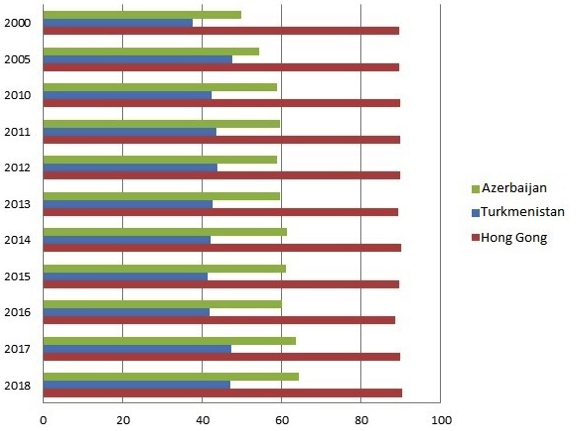
-----
Figure 2
IES values for 2018 within countries and groups
(based on the data from Knoema (2019).
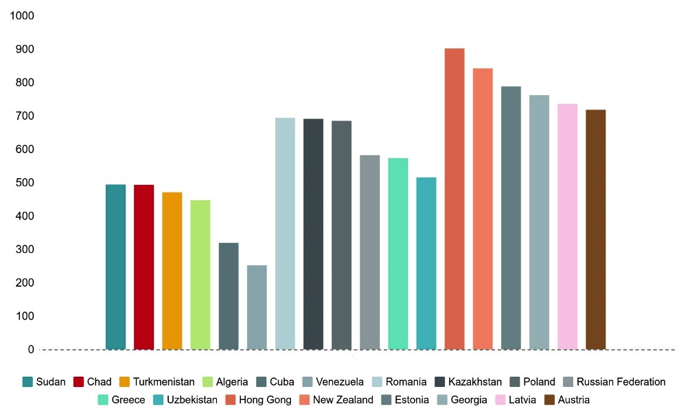
The Global Entrepreneurship Index is an economic activity parameter compiled by the American Institute for Global Entrepreneurship and Development, which considers how separate countries around the world allocate resources for entrepreneurship development (The methodology of the Telefonica Index on Digital Life (TIDL), 2019). Figure 3 presents estimates of the Global Entrepreneurship Index for some countries. It should be noted that the rating of countries under this index differs significantly from the IES.
Figure 3. Global entrepreneurship index (based on the data from Knoema (2019).
The Index of Digital Life (TIDL) reflects a consistent capacity of countries to encompass a digital life through this three main categories: (1) digital transparency, meaning how far the country digital infrastructure provides an open access to information; (2) digital trust; which means how easily and confidently people and organizations interact with the country digital infrastructure; and (3) digital entrepreneurship, referring to how easily citizens and organizations use digital infrastructure for entrepreneurship and innovation. In line with this, the index tracks other three system capacities in 34 countries: digital openness (Internet freedom and availability, digital public services), digital confidence (digital adaptability, confidentiality and security) and digital entrepreneurship (digital literacy, digital business, innovation and finance).
Table 1 shows TIDL values and the sub-index relative to GDP per capita for some countries (The methodology of the Telefonica Index on Digital Life (TIDL), 2019). It specifies important discrepancies both within and between sub-indices. Canada ranks first in the Digital Openness ranking, followed by the United States and the United Kingdom. The United States ranks first under digital reliance, followed by Australia and the United Kingdom. The USA also ranks first under digital entrepreneurship, followed by Canada and Australia. The column “Relative to GDP” shows the difference between the actual indicator and the one forecasted on the basis of GDP. Positive values indicate performance and negative values indicate insufficient performance compared to the forecasted value.
Table 1
Digitalization indices (adapted based on the reference
“The methodology of the Telefonica Index on Digital Life (TIDL)” (2019).
Country |
TIDL Index 2016 |
Digital Openness Sub-Index |
Digital Confidence Sub-Index |
Digital Entrepreneurship Sub-Index |
||||
Index Score |
Relative to GDP |
Index Score |
Relative to GDP |
Index Score |
Relative to GDP |
Index Score |
Relative to GDP |
|
Argentina |
62,30 |
2,40 |
65,90 |
4,30 |
66,90 |
5,80 |
54,10 |
-7,20 |
Australia |
90,10 |
9,10 |
89,90 |
7,20 |
95,90 |
11,10 |
84,40 |
2,00 |
Brazil |
62,00 |
3,40 |
69,00 |
8,80 |
61,50 |
2,00 |
55,40 |
-4,50 |
Canada |
92,40 |
11,30 |
100,00 |
17,20 |
88,60 |
3,70 |
88,70 |
6,20 |
Chile |
70,40 |
6,70 |
65,30 |
-0,10 |
67,80 |
2,40 |
78,20 |
13,10 |
China |
58,30 |
1,80 |
54,70 |
-3,40 |
58,30 |
1,10 |
61,80 |
4,00 |
Colombia |
67,40 |
10,90 |
71,10 |
12,90 |
65,10 |
7,80 |
66,10 |
8,20 |
Costa Rica |
60,20 |
2,40 |
56,30 |
-3,20 |
62,40 |
3,70 |
61,80 |
2,60 |
Czech Republic |
71,10 |
0,90 |
71,10 |
-0,80 |
77,50 |
4,90 |
64,60 |
-7,00 |
Ecuador |
54,30 |
-0,70 |
58,30 |
1,70 |
52,30 |
-3,20 |
52,30 |
-4,10 |
Egypt |
50,50 |
-3,80 |
54,10 |
-1,90 |
50,90 |
-3,80 |
46,60 |
-9,10 |
El Salvador |
52,00 |
-0,50 |
51,70 |
-2,50 |
50,60 |
-2,20 |
53,80 |
-0,10 |
France |
78,30 |
1,40 |
80,00 |
1,40 |
73,10 |
-7,10 |
81,90 |
3,50 |
Germany |
81,00 |
-1,50 |
75,30 |
-8,90 |
84,40 |
-2,10 |
83,20 |
-0,70 |
Guatemala |
48,00 |
-3,80 |
42,50 |
-11,00 |
46,10 |
-5,90 |
55,50 |
2,30 |
India |
54,40 |
4,00 |
59,30 |
7,20 |
44,90 |
-5,50 |
59,10 |
7,30 |
Israel |
78,50 |
6,00 |
74,40 |
0,30 |
78,70 |
3,50 |
82,40 |
8,60 |
Italy |
64,80 |
-8,90 |
65,40 |
-9,90 |
64,80 |
-11,70 |
64,10 |
-10,90 |
Japan |
77,30 |
2,30 |
85,00 |
8,30 |
79,00 |
0,90 |
67,80 |
-8,60 |
Mexico |
65,30 |
5,80 |
68,40 |
7,20 |
64,20 |
3,50 |
63,40 |
2,50 |
Nicaragua |
47,6 |
-2,20 |
51,4 |
-0,10 |
43,3 |
-6,40 |
48,2 |
-3,00 |
Panama |
56 |
-6,60 |
47,2 |
-17,00 |
52,2 |
-11,90 |
68,7 |
4,70 |
Peru |
57,3 |
1,90 |
45,5 |
-11,60 |
63,8 |
7,70 |
62,7 |
5,90 |
Poland |
58,3 |
-7,4 |
55,5 |
-11,8 |
61,1 |
-6,4 |
58,3 |
-8,7 |
Russia |
66,9 |
5,5 |
74,5 |
11,4 |
69,6 |
6,9 |
56,7 |
-6,1 |
Saudi Arabia |
69,4 |
-18 |
60,3 |
-28,8 |
63,5 |
-28,5 |
84,3 |
-4,5 |
South Africa |
62,1 |
5,8 |
71,2 |
13,2 |
57,6 |
0,6 |
57,4 |
-0,3 |
South Korea |
70,8 |
-2,6 |
70,9 |
-4,1 |
75,2 |
-1 |
66,3 |
-8,4 |
Spain |
70,1 |
-2,3 |
66,4 |
-7,7 |
72,8 |
-2,4 |
71,1 |
-2,7 |
Turkey |
59,5 |
-1,8 |
55,4 |
-7,5 |
56,8 |
-5,7 |
66,2 |
3,6 |
United Kingdom |
88,7 |
11,1 |
93,1 |
13,8 |
90,5 |
9,4 |
82,6 |
3,6 |
United States |
96,3 |
6,8 |
97,3 |
6,1 |
97,7 |
3,3 |
94 |
3 |
Uruguay |
62 |
-0,6 |
58,1 |
-6,1 |
67,3 |
3,2 |
60,6 |
-3,4 |
Venezuela |
51,3 |
-7,9 |
50,5 |
-10,4 |
50,6 |
-9,7 |
52,7 |
-7,9 |
Based on the table 1, we can single out key points. Russia holds relatively good positions on digital openness and digital confidence, but, obviously, its weak point is digital entrepreneurship, where it occupies only the 26th place. For Saudi Arabia, there is an opposite situation. Italy scores are rather mediocre, as they rank at the 17th or 18th place in all sub-indices. Japan ranks at the 5th or 6th place on digital openness and digital confidence, but only 12th on digital entrepreneurship. Chile is on the top 10 on digital entrepreneurship (9th place), while India ranks at the second place in the world in terms of confidence.
To clarify what has been said above, let us create histograms, which allow us to compare some countries by the TIDL value and sub-indices relative to GDP per capita (figs. 4 and 5).
Figure 4
Digital economy indices (made up based on data from
“The methodology of the Telefonica Index on Digital Life (TIDL)” (2019).
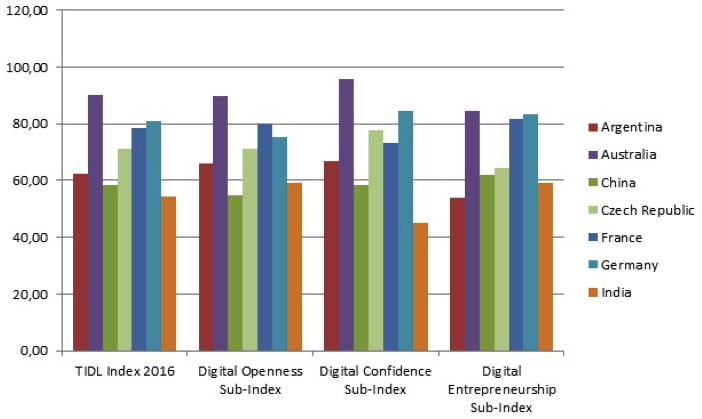
-----
Figure 5
Digital economy indices (created due to the current data from
“The methodology of the Telefonica Index on Digital Life (TIDL)” (2019).
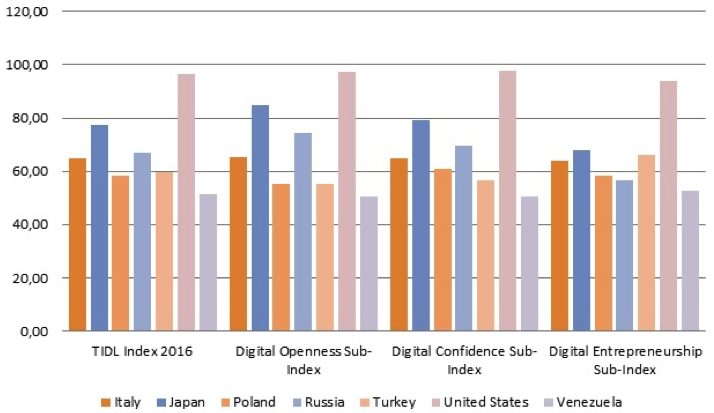
Australia and the USA have the highest TIDL values and sub-indices are relative to GDP per capita (figs. 4 and 5). In these countries, both the TIDL index and its components are close to 90. Germany, France and Japan demonstrate values of progress towards the digital economy and the digital society at the level of 80. In Russia and India these values tend to 60.
The number of internet users for the year 2000 made up only about a half of the population, even in highly developed countries, while it did not even reach 10% in countries such as Bahrain and Kuwait. However, in 2017, this index exceeded 90% for all the countries under review (fig. 6) .
Figure 6
Percentage of internet users per population
(based on data from Knoema (2019).
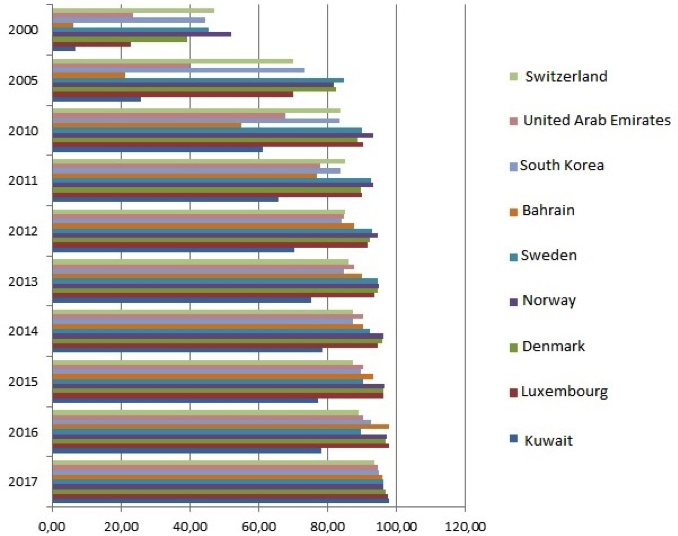
Internet is unevenly distributed around the world. The highest expansion is observed in the countries of Northern Europe (94%), Western Europe (90%) and North America (88%) (Internet in world countries, 2019).
Figure 7
Internet users per % per capita 2017
(based on data from Knoema (2019).
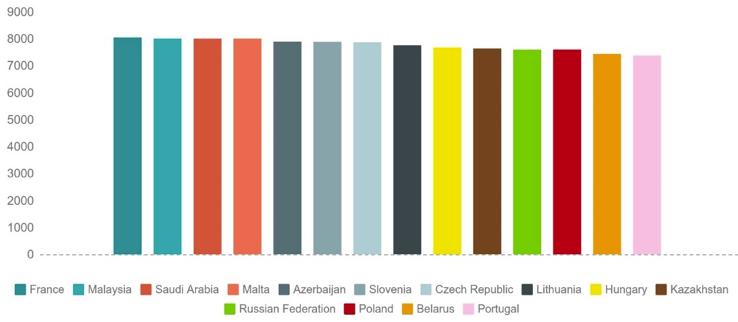
Figures 7 and 8 demonstrate that more than 80% of internet users are in Japan, Sweden, Singapore, Germany, Kazakhstan, the USA, France, Malaysia, Saudi Arabia, and Malta. Moreover, in South Korea, this parameter is close to 100%. Less than 60% of internet users are in Egypt. Еhe difference between the data reflected in Figures 7 and 8 should be emphasized separately, in Fig. 7 - the ratio of the number of Internet users to the population, while in Fig. 8 we are talking about households, although this data is close, the difference highlights the difference in the structure of using the Internet, the Internet in the household is not individualized access, this is the total payment, etc.
Figure 8
Share of households with internet (%)
(based on data from Knoema (2019).
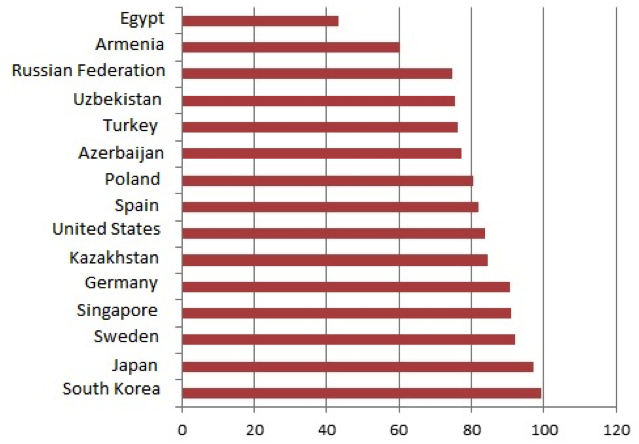
Other interesting indicator refers to the internet access by cellular mobiles telephones. The number of mobile cellular subscribers with data access, over a broadband speed in a direct channel in Singapore, increased 3 times from 2012 to 2016 (fig. 9).
Figure 9
Users of mobile broadband internet per 100 people
in Singapore (according to data from Knoema (2019).
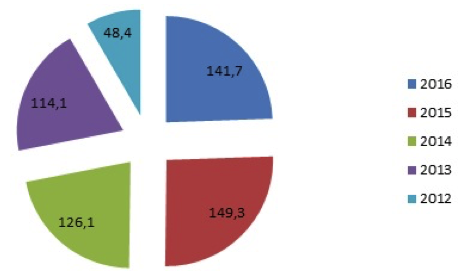
Evaluation of competitiveness is one of the most important indicators that have a significant impact on the development, not only for separate companies, but also for the national economy as a whole. The most well-known indicator in the international practice is the Global Competitiveness Index. The GCI, developed by the World Economic Forum, enables to compare the competitiveness of 134 national economies through the use of indicators such as macroeconomic conditions, government institutions, technologies, activities and strategies of companies as well as the quality of the business environment.
According to the International Competitiveness Rating, the highest achievements, more than 80%, belong to the USA, Japan and Sweden. The same countries have a high level of digitalization.
Figure 10
International Competitiveness Rating
(based on data from Knoema (2019)

The digital economy features the movement from the third industrial revolution to the fourth industrial revolution (Fomina & Mukhin, 2018; Udaltsova, 2019). The third industrial revolution, which is sometimes called a digital revolution, refers to the changes that occurred in the late 20th century, with the transition from the analog electronic and mechanical devices to digital technology. The fourth industrial revolution is grounded on the digital revolution, as modern technologies continue to unite the physical and cybernetic worlds.
While some organizations and individuals use technology to easily perform current tasks on a computer, the digital economy is more advanced than the existing one. It is not just using a computer to perform tasks traditionally manual or on analog devices. As an alternative, the digital economy emphasizes the possibility and need for organizations and individuals to use technologies with the purpose of performing these tasks better, faster and often differently than before (Skripko et al., 2018). Moreover, this term supposes the capacity to use technologies for executing tasks and to participate in activities that could not be carried out in the past. Such challenges for existing organizations to do better, more, something differently and something new are included in the relevant concept of digital transformation (Skripko et al., 2018).
Sol Berman (2012), the scientist, reviewed the digital transformation in terms of its impact on business models, urging managers to focus on two complementary actions: using digital technologies to expand collaboration, and customer interaction as well as changing current value propositions for customers subject to transformation. In addition, several institutions and scientists tried to simplify and define this process. Bounfour (2016) attempts to define it as follows: “Digital transformation is a new development in the use of digital artifacts, systems and symbols within and around organizations”. In Sweden, the Ministry of Foreign Affairs and the Strategic Analysis Secretariat commonly explain digitalization as “the catalyst, driving force and engine for the development of society over the past decades” (Park et al., 2018). The Swedish government and the Digitalization Commission inform that “digitalization means that digital communication and interaction between people, organizations and things become apparent. The ability to collect, interpret, apply and develop large data volumes in digital form opens up opportunities for development virtually in all sectors”. We can state that there is almost no organization that can protect itself from digital transformation and competitive destruction, which follows the adoption of new digital technologies and business models (Digital transformation: formation of solutioning mindset, 2019). Digitizing is, as shown above, a complex term and phenomenon that can be generalized and explained, since its properties are cross-cultural, interdisciplinary, inter-and intra-geographical, as well as virtual.
Complex indices, such as TIDL (Digital transformation: formation of solutioning mindset, 2019), can be used to support consistent comparisons between countries. However, all countries are unique in their own way. There is no single “best” or “right” model to which all countries should strive. In addition, to compare economies different in nature with high and low revenue is not very informative, as there is no sense in comparing apples and oranges, for instance. It is reasonable to use multi-element indices for comparison; for example, comparing countries with similar economic conditions can give important clues as regards finding out the strengths of each of them and what can be done to really improve the digital life in a specified country. On reading index values, it is important to remember the strengths and weaknesses of the index method. Digital life is a complex phenomenon; TIDL complexity entails it. As any indicator of a complex phenomenon, TIDL is definitely incomplete: it is impossible to cover all Digital Life complexity. Although in a carefully constructed multi-element index there is considerable value for displaying a complex phenomenon, so, the index is not and cannot be the phenomenon itself.
Despite the problems encountered in data collection, the best use of the index is the starting point for political debates in different countries, a way to draw attention to potential strengths and issues in each one, and also to pay attention to the phenomena that the index has failed to cover. Considering the limitation of multi-element indices, as the low usefulness of comparing apples with oranges, we also provide comparison with the “standard” or “expected” indices of each country, which are forecasted based on its GDP per capita. Rather often, there is information about only absolute indices in the media. However, there is herewith no mentioning about the fact that countries at different stages of development may have completely different political goals. We hope that the comparison with forecasted GDP parameters will give a more realistic overview on how each country functions.
The Digital Life index does not measure the country digital infrastructure, as there are already many indices that measure investments into digital infrastructure. However, the infrastructure itself will be static and useless if the country does not have enough opportunities for its economic and social development. This dynamic and systemic feature is exactly what the Index of Digital Life is focused on. There is substantial information in terms of expansion and quality of telecommunication networks available from various sources. Although it is necessary to support investments into telecommunication networks in order to develop them into next-generation technologies. It obviously needs to work on other Digital Life components.
We believe that the level of digitalization of a country can be measured by six key features:
• Ubiquity – the level to which consumers and enterprises have universal access to digital services and applications.
• Accessibility – the level to which digital services are rated at a range that makes them available to as many people as possible.
• Reliability – the quality of available digital services.
• Time rate – the level of access to digital services in real time mode.
• Ease of use – the ease of digital services usage and the ability of local ecosystems to accelerate the implementation of these services.
• Skill – the ability of users to make digital services as an integral part of their life and business.
We can definitely affirm that current strategic tendencies include destructive changes in the business climate, which inevitably lead to changes in networks, communities, as well as in financial markets and serious transformation. The main social and ethical tendencies have become changes in current relationships within societies, that will vary as they develop and adapt to the ongoing development of information technologies, changing future norms of behavior. The former structure of companies, groups and societies, which can be referred to organizational tendencies, is shifting in the form of their structures, processes and standards towards more flexible forms of organizations. The fact is that since information artifacts have become commonplace in the digital and physical fields, the rapid development of information and innovative technologies has become a crucial element to consider them as the key technological tendency. There are regulatory tendencies which preview that as soon as new standards and regulations appear, so, a significant preparation is required to ensure the transition to new governance formats and new regulatory authorities.
Ahmad, N., Schreyer, P. (2016). Are GDP and productivity measures up to the challenges of the digital economy? International Productivity Monitor, 30, 4-27.
Arkhangelskaya, L.Yu., Izotova, T.G. (2006). Developing and applying methods of selecting indicators for assessing the effectiveness of business entities. Proceedings of the Higher Educational Institutions, Izvestia vuzov “Geodesy and aerophotosurveying”, 3, 158-168.
Balcerzak, P., Bernard, M.P. (2017). Digital economy in Visegrad Countries. Multiple-criteria decision analysis at regional level in the years 2012 and 2015. Journal of Competitiveness, 9(2).
Berman, S.J. (2012). Digital transformation: opportunities to create new business models. Strategy & Leadership, 40(2), 16-24.
Bounfour, A. (2016). Digital futures, digital transformation. Springer International Publishing, Cham, Switzerland.
Digital transformation: formation of solutioning mindset (2019). Recovered of https://dou.ua/lenta/articles/digital-transformation-and-solutioning-mindset/
Domazet, I., Lazić, M. (2017). Information and communication technologies as a driver of the digital economy. In: XXII International Scientific Conference Strategic Management and Decision Support Systems in Strategic Management: proceedings (pp. 11-19). Ekonomski fakultet, Subotica.
Fomina, A.V., Mukhin, K.Yu. (2018). Industry 4.0. Main concepts, advantages and issues. Economicheskiy vector, 3 (14), 33-38.
Internet in world countries (2019). Recovered of http://www.bizhit.ru/index/polzovateli_interneta_v_mire/0-404
Knoema (2019). Search the world's largest global database. Recovered of https://knoema.ru/
Koch, T., Windsperger, J. (2017). Seeing through the network: Competitive advantage in the digital economy. Journal of Organization Design, 6(1), 6.
Lopatin, V.A., Seryshev, R.V., Trifonov, P.V., Mukhin, K.Yu., Smirnov, V.V. (2019). Increasing the level of STP in information processing. International Journal of Innovative Technology and Exploring Engineering (IJITEE),-8(7), 583-588
Mukhin, Yu.Yu., Mukhin, K.Yu. (2017). Reengineering of public health system, based on a person-centered model, hybrid project management approaches and methods of artificial intelligence. Information technologies for the Physician», 3, 23-38.
OECD Digital Economy Outlook (2017). OECD Publishing, Paris. Recovered of http://dx.doi.org/10.1787/9789264276284-en
Pagoropoulos, A., Pigosso, D.C., McAloone, T.C. (2017). The emergent role of digital technologies in the Circular Economy: A review. Procedia CIRP, 64, 19-24.
Park, H., Jung, H., On, J., Park, S. K., Kang, H. (2018). Digital Epidemiology: Use of Digital Data Collected for Non-epidemiological Purposes in Epidemiological Studies. Healthcare informatics research, 24(4), 253-262.
Promoting investment in the digital economy (2017). UNCTAD digital strategies survey. Recovered of https://unctad.org/en/PublicationsLibrary/webdiaepcb2017d2_en.pdf
Rotz, S., Gravely, E., Mosby, I., Duncan, E., Finnis, E., Horgan, M., ... Pant, L. (2019). Automated pastures and the digital divide: How agricultural technologies are shaping labour and rural communities. Journal of Rural Studies, 68, 112-122
Skripko, D.A., Silantieva, A.I., Silantiev, I.A., Minasova, N.R., Kazmina, M.S. (2018). Digital economy. International scientific and technical journal “TEORIIA. PRAKTIKA. INNOVATSII. Recovered of http://www.tpinauka.ru/2018/02/Skripko.pdf
The Heritage Foundation (2019). Recovered of https://www.heritage.org
The methodology of the Telefonica Index on Digital Life (TIDL) (2019). Recovered of https://thegedi.org
Tsyganov, S., Apalkova, V. (2016). Digital economy: a new paradigm of global information society. Ekonomické Rozhl'ady/Ecomomic Review, 45(3).
Udaltsova, N.L. (2019). Digitalization of economic processes within industrial revolution concept 4.0.Kreativnaia ekonomika, 1.
Valenduc, G., Vendramin, P. (2016). Work in the digital economy: sorting the old from the new (No. UCL-Université Catholique de Louvain). Brussels: European Trade Union Institute.
Vovchenko, N.G., Andreeva, A.V., Orobinskiy, A.S., Filippov, Y.M. (2017a). Competitive advantages of financial transactions on the basis of the blockchain technology in digital economy. European Research Studies, 20(3B), 193.
Vovchenko, G.N., Tishchenko, N.E., Epifanova, V.T., Gontmacher, B.M. (2017b). Electronic currency: the potential risks to national security and methods to minimize them. European Research Studies Journal, 20(1), 36-48.
Watanabe, C., Naveed, K., Tou, Y., Neittaanmäki, P. (2018). Measuring GDP in the digital economy: Increasing dependence on uncaptured GDP. Technological Forecasting and Social Change, 137, 226-240.
1. Doctor of Economics, North-West Institute of Management of the Russian Academy of National Economy and Public Administration, Saint-Petersburg, Russia. mkoniagina@bk.ru
2. PhD in Philological Sciences, Tula State University, Tula, Russia
3. PhD in Economics, The Federal State-Funded Educational Institution of Higher Education Financial University under the Government of the Russian Federation, Moscow, Russia
4. PhD in Economics, The Russian State University for Tourism and Service, Pushkino, Russia
5. Master in Business Administration, Carlos III University of Madrid, Madrid, Spain
6. PhD in Economics, North-West Institute of Management of the Russian Academy of National Economy and Public Administration, Saint-Petersburg, Russia